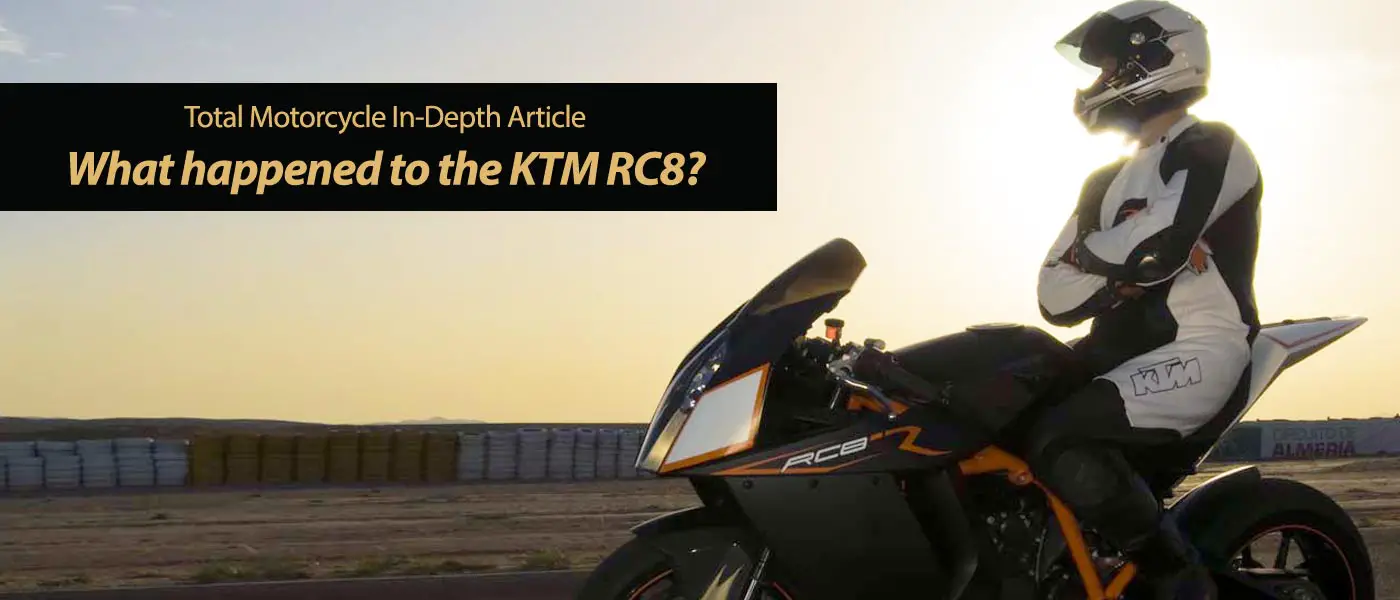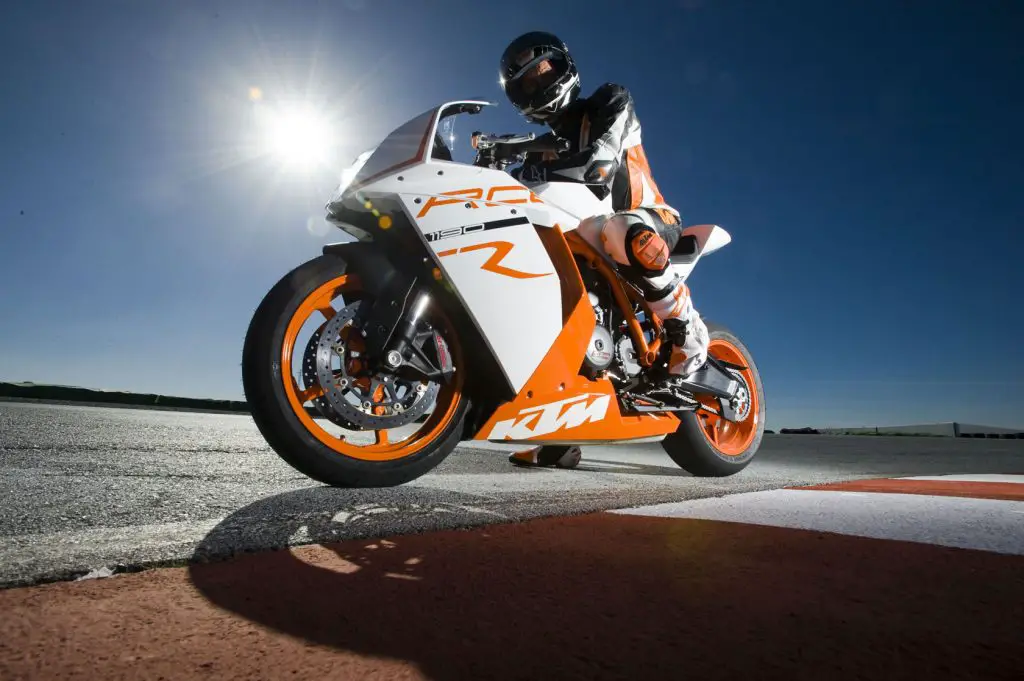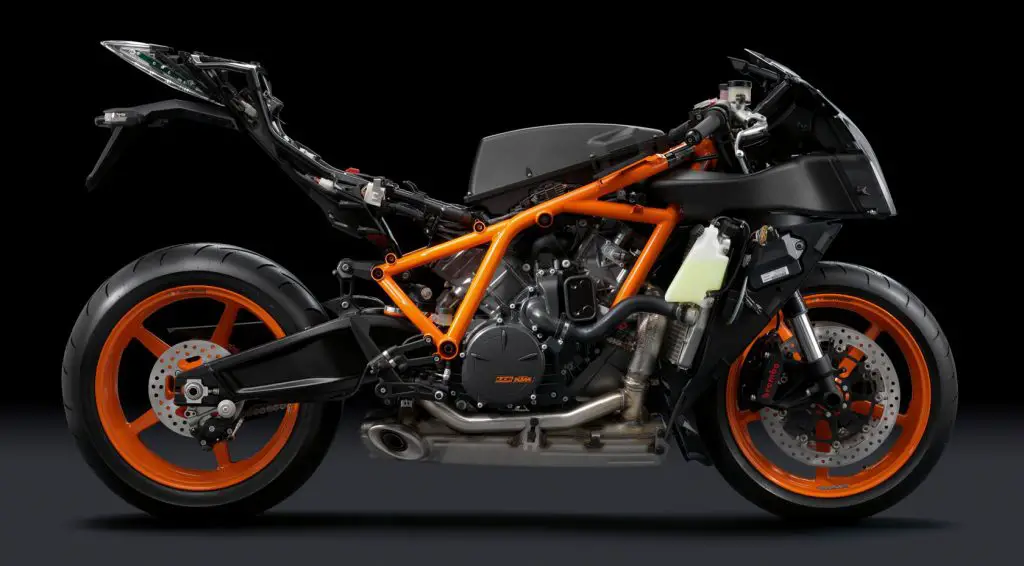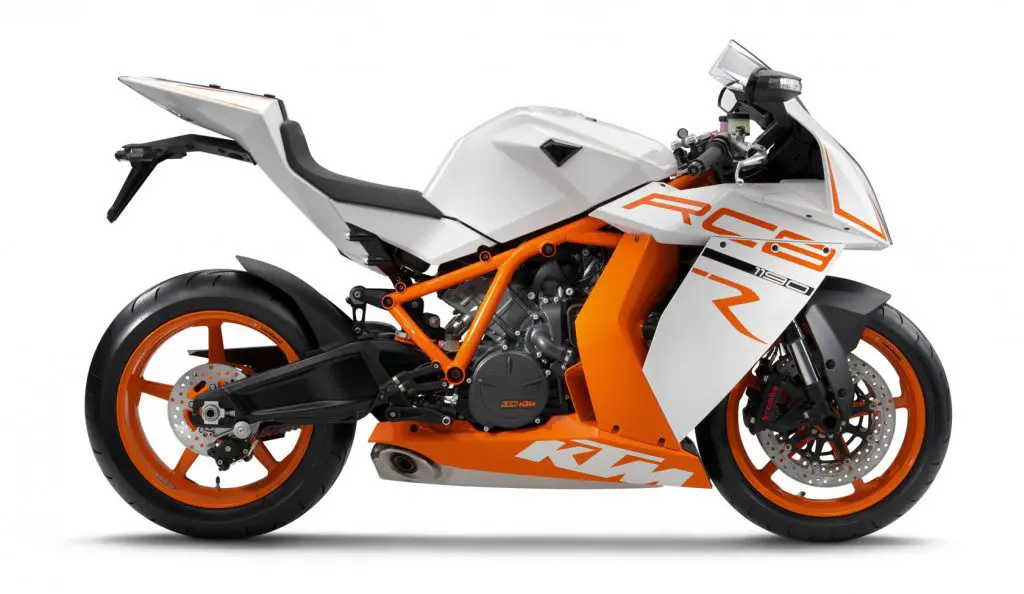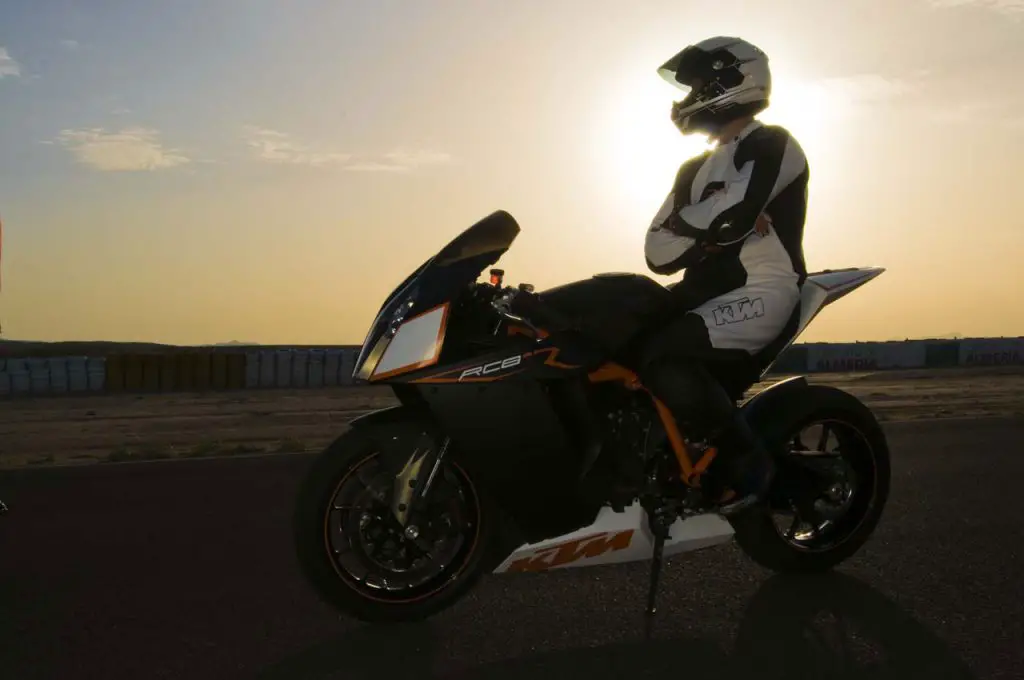
The KTM RC8 was a product of ambition, an ice-breaking machine to take on Japan’s best, offer a perfect road bike and race in MotoGP but was hit by setbacks, financial crashes and three unlucky things. Completion from Ducati’s 1098, Yamaha’s YZFR1, Suzuki’s GSX-R 1000 and BMW’s S1000RR was fierce. Starting life a 1200 v-twin moped, going through 50 engine variations the KTM RC8 was reveled at the 2003 Tokyo Motor Show. In the end, 5000 models would make it off the assembly lines to lucky riders. The bike it had huge mid-range: It was incredible and pulled like a train and won awards and accolades from motorcycle journalists worldwide but what happened to the KTM RC8? Read on…
At the turn of the decade KTM manufactured one of the most striking and surprising superbikes on the market but in a few short years it was gone. What happened to the RC8?
Wolfgang Felber leans back in his seat. The former racer and lead technician has had a hand in many KTM projects and was a leading figure in the company’s emphatic first step back to MotoGPTMwith the Moto3 KTM RC 250 GP in 2011. Talk of the RC8 – an initiative that he led and steered – brings a certain air of satisfaction to his demeanor.
KTM’s first superbike was initially (and surprisingly) unveiled as a prototype at the 2003 Tokyo Motor Show. “When we fight Japan, we want to fight them in their own office,” claimed current R&D Head Philipp Habsburg upon the bikes eventual launch. “The reaction was very enthusiastic … ”
Prior to the crisis that slapped the global economy towards the end of the decade, KTM were on a firm path to expansion and diversification (something that they would eventually resume, streamline and accentuate after the financial fallout). Part of that process was creation of model that would enter a sportsbike market that was still popular and seeing motorcycles like Yamaha’s YZF-R 1, Suzuki’s GSX-R 1000 and BMW’s S1000RR inspire the fray.
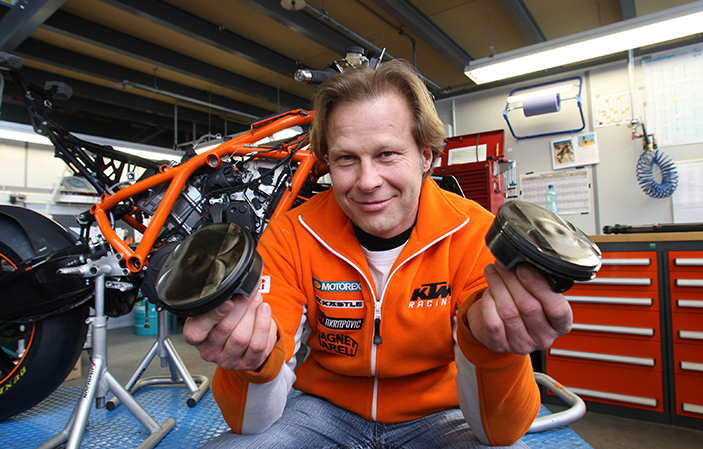
Wolfgang Felber @KTM
It was a bold move for the brand that had opened eyes with the SUPER DUKE road bike in 2005 and was a significant player outside of the offroad core of the company. “We started work on the RC8 thirteen years ago and KTM was more of a niche supplier then,” explains Felber.
“I remember back in July 2005 when the project was green-lit for development,” he continues. “As with most initial new projects in KTM there was not really the in-house specialists at the company, so we developed the bike while also hiring and training the people to get it done.”
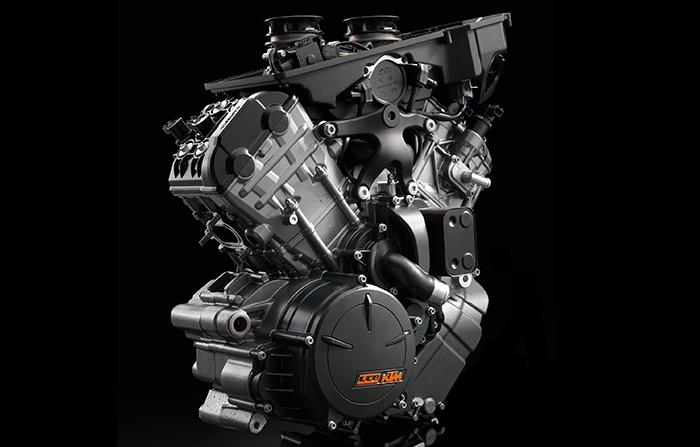
KTM allegedly sunk 10 million euros into a philosophy that a smiling Felber recalls as “a 1200 v-twin ‘moped’!” But, as with most innovations that see the light of day at Mattighofen, experimentation had started before that dramatic unveiling in Tokyo and well before a young designer (now Lead Creative at the Kiska agency and the power behind the KTM 1290 SUPER DUKE R and latest KTM models) by the name of Craig Dent would be awestruck by the sight of the RC8 on the front of a British weekly motorcycling newspaper.
“When we made the first 950cc V-Twin engine back in 2001-2002 we had already done a very rough Superbike prototype together with a German race bike manufacturer,” Felber recounts. “We used them as our workbench. Then there was another prototype that had even more of an RC8 design about it and was built in 2001. Then there was also the show bike built for Tokyo. During the RC8 development there were constant questions about why it was taking so long! But the bike did not officially begin life until the summer of 2005, so two-and-a-half years before it was confirmed to come into stock production.”
The RC8 was a product of ambition, and the technical architecture was advanced but it was also a victim of misfortune and, crucially, timing. “There were three unlucky things,” says Felber. “One was the sudden death of one of our chief engineers on September 2, 2006. A big shock. It was a big hurt for all of us, and of course the project and engine development. The second thing was the economic crisis in 2008; the bike was being produced at the same time that everything started to crash. The third thing was that – around that time – instead of eight or nine suppliers to the segment there were five and the market shrank dramatically from one day to the next.”
KTM were winning 125cc and 250cc Grands Prix but MotoGPTM was unstable with changes in the capacity limit between 1000cc and 800cc and eventually a CRT sub class. Superbike and the production regulations seemed a better arena for KTM’s first track weapon. Of course, the RC8 was not conceived merely as a pro racer’s tool or a rich person’s toy.
The RC8 offered a preview to the ‘slight of hand’ that the KTM 1290 SUPER DUKE R would eventually deliver: In other words it looked and promised to be one thing (with the SUPER DUKE it was this image of being ‘The Beast’) but ended up being something a whole lot more. “The RC8 was not designed just to be a WorldSBK base,” says Felber in the confines of a meeting room in the old Race HQ in Munderfing. “We wanted to have a perfect road bike as well. That was the beginning of the philosophy towards it and that’s why the motorcycle is roomy and adjustable. It was more of a racebike by accident finally.”
Despite the step into the unknown and the difficulties that 2007-2009 would bring KTM did not ease-off the gas (Felber: “there was always good support.”). The investment remained steadfast and apparently almost 50 engines bit the dust to get the RC8 just right. 8000 models would make it off the assembly lines, into the packing crates and the hands of curious customers.
The R&D crew funneled a stream of torque into the rider’s right hands. Even into some of the best in the business. “I was surprised how good it was as a road bike when we made a comparison test,”says former Grand Prix winner Jeremy McWilliams. “It was able to hold its own really easily, especially with the chassis. It was one of the easiest bikes you’ll ride on the road or the track.”
There were other redeeming features. “I wanted to set a new benchmark for manufacturing quality for KTM but also in general,” says Felber. “If you look at the welding on the frame and how the wiring harness was made ‘invisible’. There is not a single piece of improvisation on that bike. We spent a lot of time on it. The other thing I’m proud of is the technical layout and how you can work on the bike. It’s not such a big deal for the average customer who will leave it in the dealer or garage for any maintenance or repair but I was a racer and I worked on all my bikes by myself. I recently changed the frame on my own RC8 from black to orange and I did it in one afternoon. I think mechanics like to work on that bike.”
And of course there were those looks. Felber: “I knew we were making something powerful. Kiska’s work is always polarizing with their styling. In fact, it is not just styling; it is a statement. If you see the RC8 nowadays it is like it’s a bike from 2025. I love that approach. It is not a bike for everyone. It was polarizing: Both for the look and the technical layout with that under-slung exhaust system that made it appear totally different, and the small and narrow tail section.”
On the track, the RC8 was being raced to top five results in AMA Superbike by the likes of Chris Fillmore and even starring at the Isle of Man TT. In Europe KTM established a team to enter the competitive IDM German Superbike series. “The IDM was more-or-less a European Championship,”says Felber. “It was fully open for tire development and no restrictions on things like electronics.”The RC8 would go on to beat the competition. More important than results however was the chance for KTM to learn about road racing. It was a process that fed directly into their stunning Moto3 Grand Prix title-winning debut.
The RC8 was the ice-breaking machine that made the journey for Moto3 and thus MotoGPTM much smoother. “The IDM was an ideal playground to develop the bike but also people,” says Felber. “We raced for three seasons and it was extremely useful. We were learning a lot about tires together with Dunlop, and we won the title. We reached a level where we were able to tell [Magneti] Marelli how and what we wanted to change with our electronic software. That all fed into the new Moto3 project because it was clear that 2011 would be the last in the German Championship before all the people moved into Moto3. We had to start early actually, and I had to split people between IDM and Grand Prix. In the end we had a fully capable and working group for road racing.”
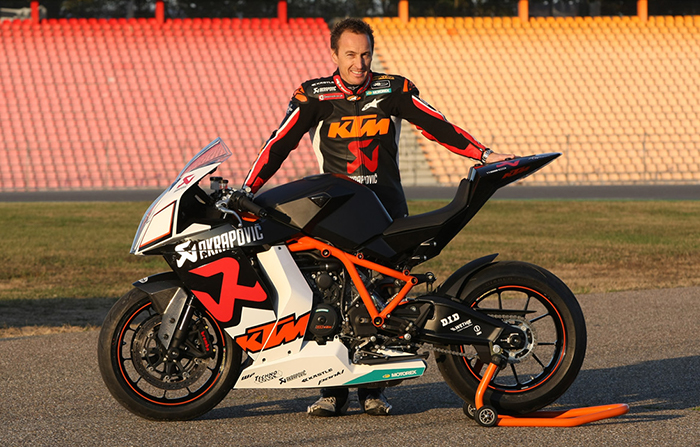
Jeremy McWilliams @KTM
While the RC8 was being modified and chiseled in Germany McWilliams was also running a separate test program. “We got Jeremy on the bike after remembering him well from the originalMotoGPTM project and still, to this day, he is fantastic to work with and still so fast with so much expertise over what seems like fifty years of racing!” Felber grins. “He’s loyal, honest and he’ll never talks lies.”
“To be honest it was a big surprise to jump on the IDM version of the RC8 with the full-on Magneti Marelli spec from the road bike,” he remembers. “The improvement in performance was an eye-opener. Whatever Wolfgang and the boys had done with the bike it had huge mid-range: It was incredible and pulled like a train. I still haven’t ridden anything like it to this day that makes that kind of torque and mid-range power. Wolfgang told me it was still only making 185-87 horsepower but it felt like 210; it was that good.”
As with almost every motorcycle there were imperfections and the rough waters around the development and production bore an influence. “We were aware that we’d need some good electronics on the bike, but due to the 2008 crisis there were thumbs on budgets everywhere and we did not get the chance to develop it in this term,” Felber says.
Journalists were quick to praise the RC8’s strengths upon its introduction but they also identified some of the quirks. “Idiosyncrasies? I guess the slightly rough gear change, and also those typically unmistakable looks, which I’m not sure enough people liked,” says renowned British bike tester Roland Brown. “And the fact that by sportsbike standards it was so comfortable and versatile, but I don’t think it got enough credit for that.”
On the whole KTM had hit the mark. “I remember it was well received and I think it also sold well in the first year, especially in Great Britain,” Felber says. “I think 2000 bikes from the 2008 generation were sold there; that’s a sign that it was accepted by customers.”
Towards the end of the second decade of the century it is gaining almost cult status. Particularly as KTM indulge more and more in road racing. “I and many of the other journos thought it was very competitive with Ducati’s 1098, which is pretty high praise,” says Brown.
A competitive bike and a highly rated one: So why is the RC8 no more? The change in the WorldSBK playing field was the first ‘closing of the door’. Felber explains why: “The bike was planned as a 1000cc superbike. The engine was going to be a robust 1000cc capacity with the potential for enlargement over the years and this quickly became the case as Ducati forced the FIM to set the new limit to 1200cc. We were somehow on the wrong rail. The intake section with the throttle body dimensions was designed for a 1000. When we became aware that we’d need to beef it up to 1150 (initially) and then 1200 the deadline was already gone to increase the throttle body. This was one of the ‘birth defects’ of the RC8. It was not a disadvantage at all for the production bike – in fact it was a big help because with smaller units you get better gas flow and better rideability – but it always limited us in top power to enter WorldSBK.”
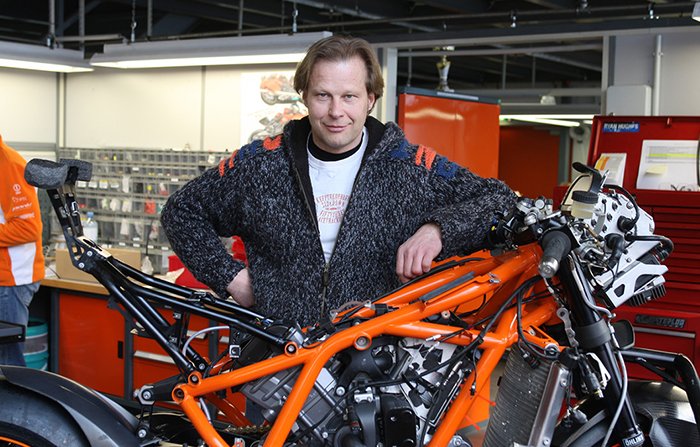
Wolfgang Felber @KTM
“There was a new version with new throttle bodies in the prototype stage, which at the time did 215hp, not too bad but we never got the release to switch it into production and have the proper base for world superbike racing,” he adds. “It was simply a company strategic decision in 2011 to go Grand Prix racing instead of WorldSBK because we could not do both … and it was the right decision. We were always very busy and were a small group so there was not too much time to be disappointed that we did not see the RC8 in World Superbike.”
As a track asset the RC8 had limited use, but surely there was a case for keeping it in the KTM portfolio? In the end the project fell afoul of other priorities and the allocation of resources. “I cannot really answer the question as to why the RC8 is not here anymore, but I can give a few points of view. KTM always ran an economic growth policy, so you had the small displacement bikes coming along, the new SUPER DUKE and many other projects. I think KTM simply had to choose where to put our R&D efforts and a SUPER DUKE or a smaller DUKE brings in more money and is more strategically important than an RC8. We have new customers. It was the better solution. There were also some comments from Mr. Pierer about the speed of Superbikes and they should just be on the track. I mean, a SUPER DUKE is also a fast motorcycle and in the end I think it was just a matter of resources and economic calculation.”

Jeremy McWilliams @KTM
For those that rode or raced the RC8 the bike was missed. “I still think to this day it still stacks up against what other manufacturers do,” says McWilliams. “Of course, everything has moved on in terms of electronic wizardry but we would have done the same with the RC8. I got to ride it – the original IDM bike – again at the end of last summer and it brought home how good it was as an all-rounder. If we had the chance to make a 1290 with the same chassis I think it would be back up there as ‘one of the bikes to have’ in the garage. It was a shame that it wasn’t kept alive. I’m still hoping – as are some of the other guys in R&D – that it will be resurrected at some stage!”
The RC8 was a technical, stylish and functional template for KTM’s road bikes and ‘accelerating’ racing division. It was also a memorable edition to the company’s history: Perhaps even the ultimate definition of KTM’s DNA to affect and move motorcyclists. “Given KTM’s amazing success since, I guess you’d have to say that Stefan Pierer got it right as usual and made the correct call to invest in other stuff rather than throw more resources at that rapidly shrinking market,” concludes Brown. “It would have been great to see them continue the development though. I guess it’s never too late to change his mind and make a MotoGPTM replica … ”
– Total Motorcycle Would like to Thank KTM for bringing our readers such an indepth look into what happened to the KTM RC8. Thanks KTM!


